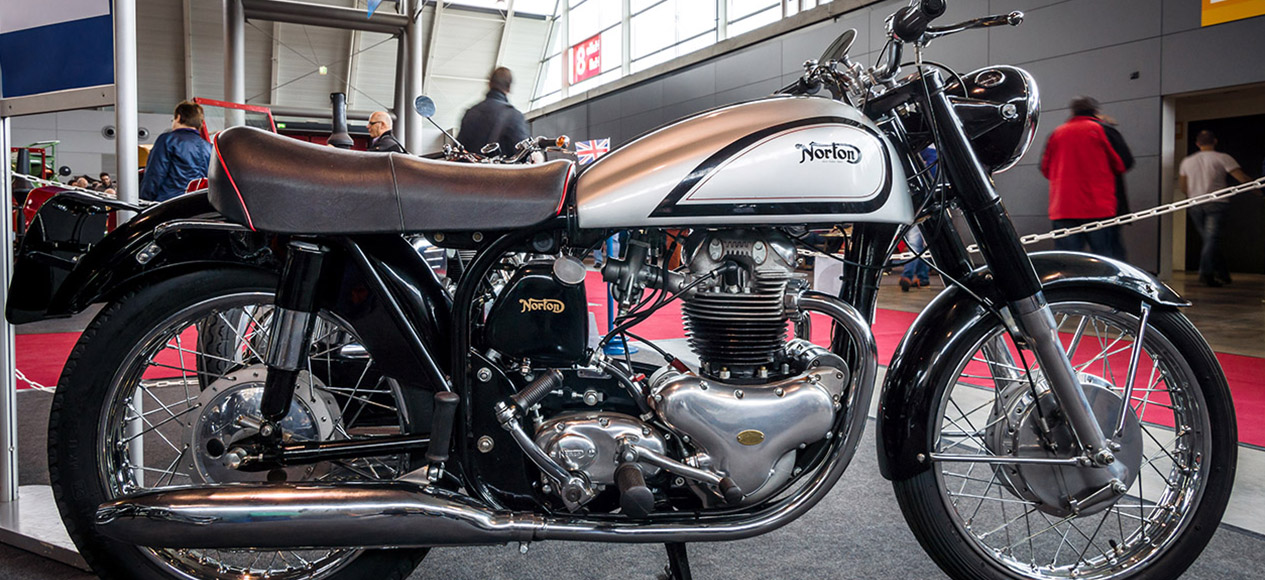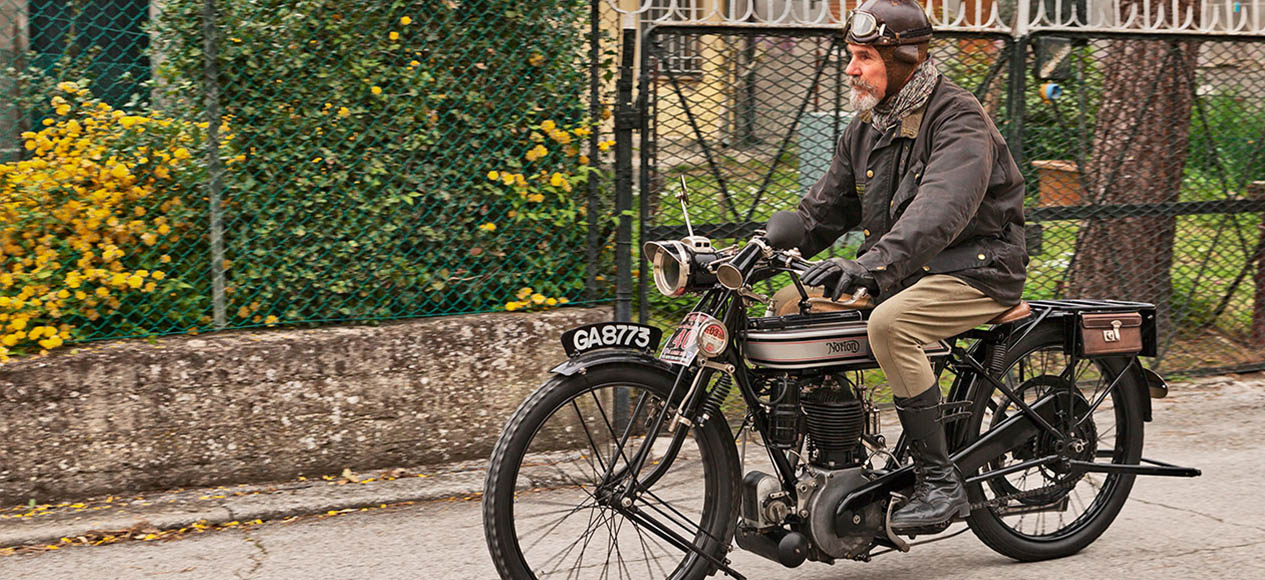As one of the most famous British motorcycle brands of all time, Norton remains one of the most emotive and iconic marques today. Famous for their classic models from the 20th century, the company is back in business today – hand building an eclectic range of models ranging from authentic retro classic reboots of the famous Commando through to an all-new 200bhp, 1200cc V4 superbike.
The company was founded by James Lansdowne Norton, in Birmingham, in 1898. The company made its first motorcycle four years later using, as was the norm, bought in engines in a chassis designed and built by Norton.
In 1907, Rem Fowler won the twin-cylinder race at the first ever Isle of Man TT – riding a Norton motorcycle powered by a French Peugeot engine. The following year Norton started producing its own engines, a range of side-valve singles that would see service right through the war years.
Norton gained a reputation as a sporting brand and held numerous world speed records prior to World War One. Production was halted during the war years but resumed in 1919. Norton was also a fixture at the Isle of Man TT races, where it continued to enjoy great success.
World War Two saw production dedicated to military motorcycles from 1936 to 1945, and when the Isle of Man TT races resumed Norton again produced the bikes to beat, winning the Senior TT every year from 1947 to 1954.
In 1949, the motorcycle world championships began – the precursor to today’s MotoGP series – and Norton won the first ever 500cc Grand Prix, with Harold Daniell victorious at the Isle of Man Senior TT on 17 June 1949.
Norton was a major player in the early years of Grand Prix racing, winning the 1951 500cc title with Geoff Duke, and even when the Italian multi-cylinder machines from MV Agusta and Gilera started to dominate the racing, the Norton still proved to be a trusty and competitive option for privateers.
Along with Triumph and BSA, Norton enjoyed the golden era for British motorcycles in the 1950s and 1960s. The Norton Dominator, a 500cc twin, was introduced in 1949 to much acclaim, while the race bikes enjoyed great success with the new ‘Featherbed’ frame.
Designed by Northern Irish racing brothers Rex and Cromie McCandless, the Featherbed was given its nickname in 1950 after Harold Daniell first tested it and quipped that it was like ‘riding on a featherbed’.
The Featherbed design moved on motorcycle chassis design considerably at the time and gave Norton a reputation for building fine handling motorcycles (many specials builders would later mate the stronger Triumph engine with the Norton frame to create the ‘Triton’). Featherbeds were expensive to make, as they used long lengths of Reynolds tubing, which was welded into a twin loop design that was lighter and more rigid than other frames of the time. The Featherbed first found fame in the legendary Manx Norton. The Manx was Norton’s race bike, which was produced between 1947 and 1962 in 350cc and 500cc forms.
As the name suggested, the Manx was developed to race at the Isle of Man TT races and it was a highly competitive machine not only on the Island, but in the early years of Grand Prix racing. Even after Norton ended its works team in 1954, the Manx proved to be the bike of choice for privateer racers and even today is a popular choice in classic motorcycle racing.
In 1953, Norton was sold to Associated Motorcycles, who also owned the AJS, Matchless, Francis-Barnett and James brands, and production was moved to London. Norton’s frame technology took another step forward in 1968, when the 750cc Commando appeared, with a rubber mounted engine and gearbox subduing the vibrations associated with big twins, in particular Norton’s motors, of the time. The Commando sold reasonably well but came at a time when four-cylinder Japanese bikes moved the game on technically. Combined with widespread industrial action in the 1970s, Norton and the other British manufacturers faced tough times.
In 1973 Norton merged with BSA and Triumph to create Norton-Villiers-Triumph, but the brand effectively went into hibernation two years later, when the UK government called in its loans to the ailing company.
The rest of the 1970s and early 1980s were quiet times for Norton. At the time of winding up, the company had been working on a Wankel rotary design engine, a technology which had been attracting interest from some 1970s car makers, including NSU (later Audi) and Mazda, and this would see the light of day in 1984, when the Norton Interpol was introduced. This fully faired tourer, in the style of a BMW R100RT, was not sold to the public, rather in small numbers to British police and military fleets, and the RAC breakdown service, where it was used by patrol officers.
A consumer version, the Commander, went on sale in 1988, preceded by the unfaired Classic, but the most famous Norton rotaries were the F1s of 1990 and 1991.
The Norton F1 was based on the factory RCW588 racers, which competed with some success in British superbike racing, and even made appearances in 500cc Grand Prix racing. The rotary engine caused confusion with rule makers. Officially the twin rotor engine’s capacity was given at 588cc but they were allowed to race against the 500cc two-strokes in Grand Prix, and 750cc four-strokes in superbike racing. The bikes were very fast and famously Steve Hislop won the 1992 Isle of Man Senior TT on one, defeating Carl Fogarty in one of the greatest TT races of all time. Another Scot, Ian Simpson, won the British superbike on a Norton rotary in 1994.
Despite the racing success, Norton was in trouble. Production of the rotary ended in 1992 and the brand went through a period of uncertainty, with the rights to the name changing hands several times but no new bikes being developed.
American Norton enthusiast Kenny Dreer owned the brand in the late 1990s and had been developing a new 961cc Commando, but the company came home in 2008 when English entrepreneur Stuart Garner bought the rights to the name.
Completely reengineering the Dreer design, the revived Commando was built at a new facility within the grounds of Donington Park race circuit. After securing funding from the UK government, the company has continued to expand – remaining a niche manufacturer of premium bikes but offering more variants than ever before.
Despite being traditional air-cooled twins, the Norton Commando range meets the latest emissions regulations. Garner has also been active at the TT with a factory racer utilising Norton’s own frame (designed by Spondon, now a subsidiary of Norton) and powered by an Aprilia engine. The TT project has led to an all-new 1200cc superbike with 200bhp from Norton’s inhouse engine. From this, the company has developed a 650cc twin to power the new Atlas range.
While the revived company has a long way to go to become a mainstream manufacturer once more, it is fantastic to see this most famous of British marques back in production and innovating once more.





